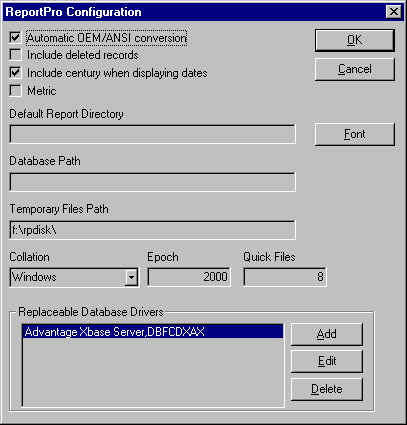|
<< Click to Display Table of Contents >> Configuring ReportPro |
  
|
Configuring ReportPro
|
<< Click to Display Table of Contents >> Configuring ReportPro |
  
|
The ReportPro Configuration dialog allows you to specify miscellaneous properties that related to the default behavior of ReportPro. The ReportPro Configuration dialog is displayed when you select File, Setup, ReportPro from the work window menu.

The Automatic OEM/ANSI Conversion checkbox allows you to select whether ReportPro will automatically convert between OEM and ANSI for existing database files that are in OEM format. If this checkbox is not checked, no automatic conversion is performed.
The Include Deleted Records checkbox tells ReportPro whether to include deleted records as it processes local tables in a data source.
The Include Century When Displaying Dates checkbox tells ReportPro whether to automatically display the century when formatting dates. For example, displaying the century for 1/9/67 would result in 1/9/1967.
The Metric checkbox sets the default ReportPro unit of measure. If this box is checked, the default unit of measurement is Centimeters; otherwise, the default unit of measurement is Inches.
The Default Report Directory edit allows you to specify the default directory used when ReportPro prompts for which report to open when Open Report is selected.
The Font pushbutton displays a dialog which allows you to select the default font ReportPro will use when creating drawing objects.
The Database Path edit tells ReportPro the default directory used when prompting for the name of a local table.
The Temporary Files Path allows you to specify the directory ReportPro will use to store its temporary files. In ReportPro/16-bit only the drive letter is used to determine the location of temporary files. In ReportPro/32-bit, the entire path specified is used.
The Collation combo box specifies the index collation ReportPro will use when creating temporary indices. Valid options are CLIPPER and WINDOWS. Set this option to CLIPPER if you wish to use or create indexes that are compatible with CA-Clipper™. Set this option to WINDOWS to create indexes compatible with international language characters.
The Epoch edit specifies the base year of a 100-year period in which all dates containing only two year digits are assumed to fall. The initial default is 1900, causing dates with no century digits to be interpreted as falling within the twentieth century.
The Quick Files edit allows you specify how many quick references to files ReportPro will display on the File menu. The value must be a number between 1 and 8.
The Replaceable Database Drivers group allows you to tell ReportPro about additional RDDs that can be used for accessing local tables.